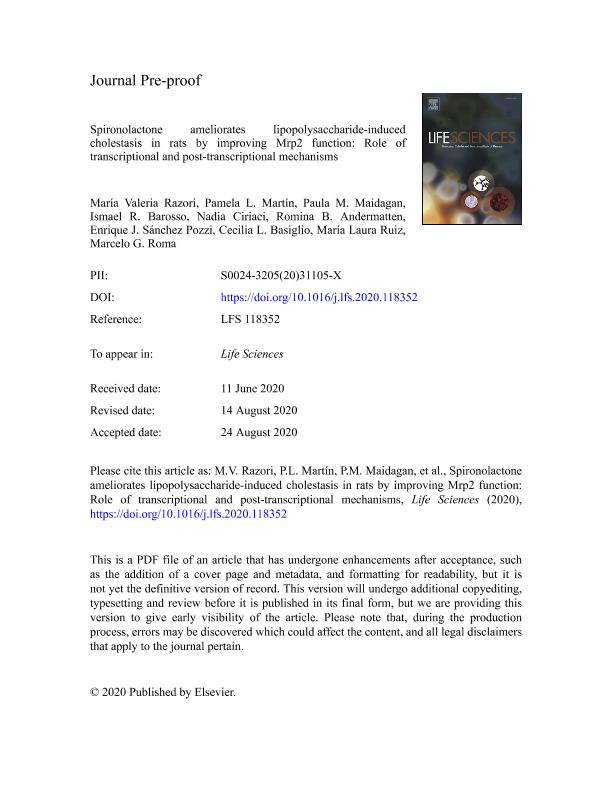Artículo
Spironolactone ameliorates lipopolysaccharide-induced cholestasis in rats by improving Mrp2 function: Role of transcriptional and post-transcriptional mechanisms
Razori, María Valeria ; Martín, Pamela Lucía
; Martín, Pamela Lucía ; Maidagan, Paula María
; Maidagan, Paula María ; Barosso, Ismael Ricardo
; Barosso, Ismael Ricardo ; Ciriaci, Nadia
; Ciriaci, Nadia ; Andermatten, Romina Belén
; Andermatten, Romina Belén ; Sanchez Pozzi, Enrique Juan
; Sanchez Pozzi, Enrique Juan ; Basiglio, Cecilia Lorena
; Basiglio, Cecilia Lorena ; Ruiz, Maria Laura
; Ruiz, Maria Laura ; Roma, Marcelo Gabriel
; Roma, Marcelo Gabriel
 ; Martín, Pamela Lucía
; Martín, Pamela Lucía ; Maidagan, Paula María
; Maidagan, Paula María ; Barosso, Ismael Ricardo
; Barosso, Ismael Ricardo ; Ciriaci, Nadia
; Ciriaci, Nadia ; Andermatten, Romina Belén
; Andermatten, Romina Belén ; Sanchez Pozzi, Enrique Juan
; Sanchez Pozzi, Enrique Juan ; Basiglio, Cecilia Lorena
; Basiglio, Cecilia Lorena ; Ruiz, Maria Laura
; Ruiz, Maria Laura ; Roma, Marcelo Gabriel
; Roma, Marcelo Gabriel
Fecha de publicación:
10/2020
Editorial:
Pergamon-Elsevier Science Ltd
Revista:
Life Sciences
ISSN:
0024-3205
Idioma:
Inglés
Tipo de recurso:
Artículo publicado
Clasificación temática:
Resumen
Aims: Lipopolysaccharide (LPS) induces inflammatory cholestasis by impairing expression, localization, and function of carriers involved in bile formation, e.g. bile salt export pump (Bsep) and multidrug resistance-associated protein 2 (Mrp2). A specific therapy against this disease is still lacking. Therefore, we evaluated the anticholestatic effects of spironolactone (SL), a PXR ligand that regulates bile salt homeostasis, up-regulates Mrp2, and bears anti-inflammatory properties. Main methods: Male Wistar rats were divided into four groups: Control, SL (83.3 mg/kg/day of SL, i.p., for 3 days), LPS (2.5 mg/kg/day, i.p., at 8 am of the last 2 days, and 1.5 mg/kg/day at 8 pm of the last day), and SL + LPS. Biliary and plasma parameters and the expression, function, and localization of Mrp2 and Bsep were evaluated. Key findings: SL partially prevented LPS-induced drop of basal bile flow by normalizing the bile salt-independent fraction of bile flow (BSIBF), via improvement of glutathione output. This was due to a recovery in Mrp2 transport function, the major canalicular glutathione transporter, estimated by monitoring the output of its exogenously administered substrate dibromosulfophthalein. SL counteracted the LPS-induced downregulation of Mrp2, but not that of Bsep, at both mRNA and protein levels. LPS induced endocytic internalization of both transporters, visualized by immunofluorescence followed by confocal microscopy, and SL partially prevented this relocalization. SL did not prevent the increase in IL-1β, IL-6, and TNF-α plasma levels. Significance: SL prevents the impairment in Mrp2 expression and localization, and the resulting recovery of Mrp2 function normalizes the BSIBF by improving glutathione excretion.
Archivos asociados
Licencia
Identificadores
Colecciones
Articulos(IFISE)
Articulos de INST.DE FISIOLOGIA EXPERIMENTAL (I)
Articulos de INST.DE FISIOLOGIA EXPERIMENTAL (I)
Citación
Razori, María Valeria; Martín, Pamela Lucía; Maidagan, Paula María; Barosso, Ismael Ricardo; Ciriaci, Nadia; et al.; Spironolactone ameliorates lipopolysaccharide-induced cholestasis in rats by improving Mrp2 function: Role of transcriptional and post-transcriptional mechanisms; Pergamon-Elsevier Science Ltd; Life Sciences; 259; 10-2020; 1-54
Compartir
Altmétricas



